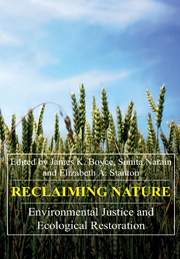Book contents
- Frontmatter
- Contents
- List of Figures and Tables
- Acknowledgements
- Introduction
- Part I ADDING VALUE
- Part II DEMOCRATIZING ACCESS
- 5 Land Reform and Sustainable Development
- 6 Extractive Reserves: Building Natural Assets in the Brazilian Amazon
- 7 Mining Rights and Community Rights: Poverty amidst Wealth
- 8 Natural Assets and Participatory Forest Management in West Africa
- Part III CAPTURING BENEFITS
- Part IV DEFENDING THE COMMONS
- About the Contributors
- Index
6 - Extractive Reserves: Building Natural Assets in the Brazilian Amazon
from Part II - DEMOCRATIZING ACCESS
Published online by Cambridge University Press: 05 March 2012
- Frontmatter
- Contents
- List of Figures and Tables
- Acknowledgements
- Introduction
- Part I ADDING VALUE
- Part II DEMOCRATIZING ACCESS
- 5 Land Reform and Sustainable Development
- 6 Extractive Reserves: Building Natural Assets in the Brazilian Amazon
- 7 Mining Rights and Community Rights: Poverty amidst Wealth
- 8 Natural Assets and Participatory Forest Management in West Africa
- Part III CAPTURING BENEFITS
- Part IV DEFENDING THE COMMONS
- About the Contributors
- Index
Summary
Introduction
Brazil occupies four-fifths of the Amazon Basin and is home to the world's largest remaining area of tropical rainforest, 3.5 million square kilometres (km2). Despite three decades of settlement and intensive development, the forest is still relatively intact compared with similar areas elsewhere. The region is an increasingly important source of natural assets for both regional and national economic growth, and provides livelihood support to a population of several million. In addition, the Amazon supplies key environmental services in terms of the conservation of biological diversity, climate regulation and watershed management, as well as sequestering an estimated 10 per cent of global carbon emissions.
Traditional forest-dwelling populations such as rubber tappers and indigenous groups have been stewards of the natural resource base in Amazonia through their use of non-destructive technologies at low demographic densities. As the frontier has advanced, however, they have come under growing peril from rent-seeking interests that threaten to destroy the forest and people's livelihoods with it. Official policies have tended to reward such predatory forms of occupation through generous subsidies, while ignoring the ecological services provided by local populations. Brazil's rubber tappers were the first social group to pose a major challenge to this ‘development’ model. Making a pre-emptive strike against cattle ranchers and land speculators, they have appropriated for themselves large areas of forest at risk of becoming ‘open access’ to all comers seeking profits.
- Type
- Chapter
- Information
- Reclaiming NatureEnvironmental Justice and Ecological Restoration, pp. 151 - 180Publisher: Anthem PressPrint publication year: 2007
- 1
- Cited by

